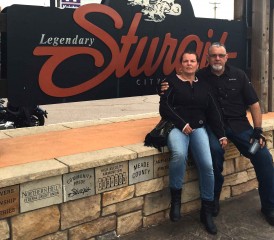Painting Helps Mesothelioma Survivor Focus on Living

Fact Checked | Written by: Tim Povtak | Last Update: 10/24/2024 | 5 Min Read
Mesothelioma survivor and U.S. Navy veteran Peter L. has good reason to feel discouragement today. He has an even better reason to keep fighting through it.
He loves what he does.
Not only was the once-promising clinical trial he participated in abruptly terminated last month, but Peter also learned he had never been receiving the experimental immunotherapy vaccine he believed was working so well.
Unknowingly, he was not receiving the vaccine in the double-blind trial the past two years. Instead, he was getting the placebo, commonly known as the sugar pill, in a controlled experiment. It left him empty.
“I have to admit, I was dejected about the news initially. It was disappointing on both counts,” he said. “But like that old saying goes, ‘One door closes, and another opens.’ I haven’t found my Plan B yet, but I’m still looking. There is no giving up.”
It’s been three years since Peter, 76, was diagnosed with pleural mesothelioma and underwent a pleurectomy/decortication surgery in New York. His last name is withheld for privacy.
Peter still looks and sounds healthy. He walks regularly with a group of other retirees around Bergen County, New Jersey. They all revel in their what-ails-them-today stories.
He and his wife still travel to Argentina to see his family. They also visit the Catskill Mountains in upstate New York. He maintains a small art studio there for his late-in-life passion for painting that invigorates him.
Mesothelioma Survivor Loves His Art
“Painting has been my medicine through this, a great diversion for me. It’s a way for me to focus on the future and not the past, which is important when you have this cancer to worry about,” he said. “It wasn’t until I retired that I had time to discover how much I loved this, and how good I could be at it.”
Peter is a mostly self-taught artist who spent his working life as a big-city business executive with a couple of well-known national firms. His mother was a sculptor. Several art galleries sell his paintings today.
Mesothelioma survivor Peter L. shares his landscape paintings.
He recently donated several pieces to a mesothelioma foundation, which used them in an auction to raise $10,000.
Peter doesn’t need the money from selling his paintings. He does it for the rush he gets from creating them. Most of his paintings are natural landscapes that capture the vibrancy of the great outdoors. Much of it is inspired by the Catskills.
“At first, I didn’t like selling them. It was like selling my babies,” he said. “But it’s been like therapy for me, both for enjoyment and stress relief. I’m doing stuff now that I can’t believe I can even do. It’s been wonderful.”
Disappointed When Clinical Trial Ended
While his artwork has helped sustain him, Peter still wonders how long it can last. He already has lived longer than the typical pleural mesothelioma patient, who has an average life expectancy of 12 to 21 months.
The sudden termination of the clinical trial testing the Wilms’ Tumor (WT1) immunotherapy vaccine blindsided him. He was told the lack of qualified patients and efficacy ended the trial.
His most recent thoracic scan showed no mesothelioma tumor progression. And he was sure the vaccine was working.
“I always thought I was getting the real thing, not the placebo. It was good for me psychologically,” he said. “But you know going in, a double-blind trial is like Russian roulette. You just don’t know what you are getting.”
Peter is considering another clinical trial now, along with other alternative treatment options. His original therapy included chemotherapy, aggressive surgery and radiation. His next scan is scheduled for early 2016.
He still believes strongly in clinical trial participation, not only for the patient, but what it can do for those who come later. There are 3,000 Americans diagnosed annually with mesothelioma, the rare and aggressive cancer caused by asbestos exposure.
Survival Is His Way of Life
Peter served in the Navy in the early ’60s, spending considerable time on various ships, where asbestos exposure was commonplace. Fifty years ago, sailors received no warning about the dangers of exposure. They are paying the price today.
“Most clinical trials fail. I know that, but you’re always looking to be that one in a million. I don’t think anyone should give up hope of finding it,” he said. “If the trial doesn’t help you, at least it will help someone who comes after you.”
Although there is no cure for mesothelioma, he remains full of hope, for several reasons. He was diagnosed with multiple myeloma, a cancer of the white blood cells, more than 12 years ago, and he has managed it successfully.
His mother was diagnosed with breast cancer at age 50, and she lived another 43 years. He also works hard to stay as physically fit as he can.
And he prays to God every day.
“Everyone’s DNA is different, and everyone seems to respond differently to treatment,” he said. “I’ve been very fortunate with this. I just hope the good fortune continues.”





